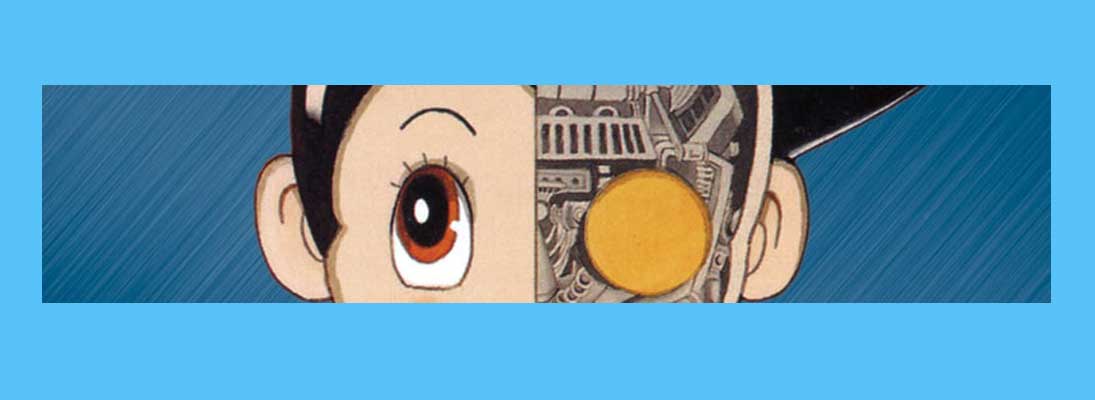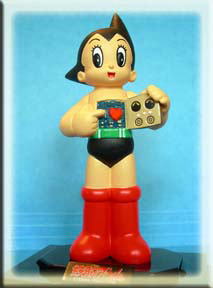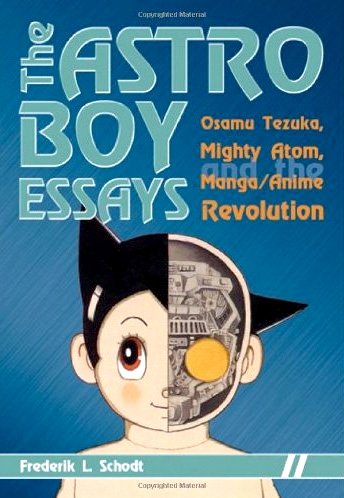
The Astro Boy Essays
Osamu Tezuka, Mighty Atom, and the Manga/Anime Revolution
Story || Cover Text || Praise || Data || TOC || Get
Story
Why did I write this book?
There are two main reasons. First, for years, people asked me if I would ever write a book about Osamu Tezuka, the "マンガの神様” or "God of Manga," in Japan. Tezuka, as his nickname implies, is a now semi-deified figure who helped kickstart the entire Japanese manga industry after World War II, and by animating many of his manga creations created the framework for today's gigantic manga-anime pop culture industry. Since I knew Tezuka well, having served as one of his interpreters and translators off-and-on between 1977 and his death in 1989, and since I had already written extensively about him in both Manga! Manga! and Dreamland Japan, this made a certain sense. But the idea of doing a whole book on such a towering, intellectual artist like him— who had created such a massive amount of material in his relatively short life—always seemed too daunting a task. So I kept putting off the idea.

Then, around 2000, the American publisher Dark Horse Comics asked me to translate Tezuka's 鉄腕アトム or "Astro Boy" series manga. This might not seem a very difficult request, but the original series was created by Tezuka between 1951 and 1981; in its core edition it consists of twenty-three paperback volumes of around 200 pages each, or around 5,000 pages. In doing this translation I became fascinated by the story—about a little boy robot with extraordinary technological powers—who tried hard to become human and in the process often became more human than those around him. Designed originally for a readership of mainly ten-year-old boys at the time, the character became a national icon in Japan, but in reading the original manga manga stories I found that—far more than the animated series later created—many of the episodes reflected Tezuka's abiding interest in the world around him and in the future. As a licensed physician and someone who read European, American, and Russian literature, Tezuka had to also entertain himself. As a result (and given the fact that the manga industry was still nascent and relatively unregulated), he indulged himself by exploring highly provocative ideas for the time such as ecology, civil rights, man-machine interfaces, artificial intelligence, drug use, and even suicide bombers. Although he began writing and drawing his story in the early 'fifties, he set it in our time, because in the storyline Astro Boy was "born" (created Pinocchio-style) on April 7, 2003. Tezuka was therefore speaking not only to his young readers nearly seventy years ago, but also to us, in our age. This fascinated me.
As a result, I realized that for me this was the perfect framework to use for a book about Tezuka, his most famous creation, and (by extension) the entire manga and anime industry in Japan.
So there you have it.

croaking Astro Boy theme song
w/ band Just Friends
Cover Text
A tribute to Japan's God of Manga by his long-time American friend and translator.
FREDERIK L. SCHODT was befriended by Osamu Tezuka in the late 1970s and maintained a close relationship with him until his death in 1989. Fluent in spoken and written Japanese, Fred frequently served as Tezuka's interpreter and is the translator of several of Tezuka's manga, including the 23-volume Astro Boy series. He is also the author of several acclaimed works on Japan and Japanese culture. Fred won the Osamu Tezuka Culture Award in 2000 for helping to popularize manga overseas. He lives in San Francisco.
OSAMU TEZUKA (1928-1989) was the pioneering genius of manga and TV animation in Japan, and Tetsuwan Atomu, or "Mighty Atom," known in the United States as Astro Boy, is his life's masterwork. Tetsuwan Atomu is the enduring story about a cute little android who yearns to be human. The history of its creation and production—and Tezuka's role in it—is as much a roadmap to understanding the development of the twin powerhouse media of manga and anime in the United States, as it is the story of Tezuka's creativity and dedication. Japan expert Frederik L. Schodt examines Tezuka's life, the art of animation, the connection betwen fantasy robots and technology, spin-offs, and Astro Boy's cultural impact. Includes over 40 black-and-white images and 16 pages of full-color Astro Boy art.
--From the back cover of the 2007 paperback edition
Praise
Comments from Reviewers:
- June, 2007. Water Bridge Review ("Book news and reviews from and about the Pacific Rim and South Asia") describes the Astro Boy Essays as a "long-awaited insight
into both Osamu Tezuka the man and the culture of animation that he spawned. Those curious about graphic novels worldwide, Japanese culture, and the history of animation
will be delighted by Schodt's witty, accessible style."
- July, 2007. About.com review of The Astro Boy Essays by Deb Aoki. Three and a half stars out of five. "[F]or anyone interested
in Japanese pop culture and the history of manga, The Astro Boy Essays
offers a rare glimpse into the world of the man who helped create manga."
- July 23, 2007. Activeanime.com review by Christopher Seaman. "THE ASTRO BOY ESSAYS is a wonderful tribute to a little robot and
the great man who created him. Full of keen insights and detailed analysis,
this book is a must read for anyone wanting to learn more about the beginnings
of manga and anime in the modern world."
- August 1, 2007. On the Ain't It Cool News website, Scott Green reviews The Astro Boy Essays as part of a survey on anime and manga-related print resources, and says
" "Ultimately, it is probably one of the most important English
language books for understanding the history of anime and manga."
- August 2, 2007. In "Books: The Man behind the Boy," in the Nichi Bei Times Weekly, Ben Hamamoto writes, "The Astro Boy Essays manages to be deep and thoughtful, but not dry or academic. It’s a fun,
engaging read, and quite lean at 174 pages, considering how much ground
it covers. Great for fans, of course, but even for those who never thought
they could be interested in manga, The Astro Boy Essays is a great study of a social phenomenon and the man largely responsible
for it."
- August 20, 2007. In a Japan Times article titled "Osamu Tezuka: Fighting for peace with the Mighty Atom," Tim
Hornyak reviews The Astro Boy Essays. "Using one of Tezuka's most famous characters as a prism to view
the man, this is a unique, engaging work that no one else could have written,
peppered with anecdotes...." He also describes it as "meticulously
researched." Tim Hornyak is a fellow fan of robots, and also the author
of a recent fine and fun book on Japanese robots, titled Loving the Machine: The Art and Science of Japanese Robots.
- August 29, 2007. In an East Bay Express article titled "Caring Robots," Anneli Rufus writes of the Astro Boy Essays that "manga scholar and Astro Boy translator Frederik L. Schodt dishes
on Japanese artist Osamu Tezuka, whose attractive androgynous long-eyelashed
little robot pacifist, created in 1951, featured in serialized comics for
more than twenty years....Cool slick color prints evoke classic episodes
such as 'Crucifix Island,' 'Melanin Tribe,' 'Fuhrer ZZZ,' and 'The Hot
Dog Corps'"
- August 30, 2007. In an Amazon review , D. Frederickson writes that the Astro Boy Essays is "a great read! ... Schodt does an amazing job breaking down Mighty
Atom/Astro Boy along with Tezuka.... If you are a fan of anime, manga,
or both, you will want to read this book...."
- September 16, 2007. Aaron H. Bynum reviews the Astro Boy Essays in Frames Per Second>("the thinking fan's animation magazine"), calling it a "wonderful
assemblage of knowledge and research regarding the influence of artist
and animator Osamu Tezuka"... "the book uses the Mighty Atom
creative property (known to Westerners as Astro Boy) to perceive, interpret
and understand both Tezuka's ingenuity and the evolution of Japan's circulated-comic
and moving picture markets."
- September/October, 2007. Lance Eaton reviews The Astro Boy Essays in ForeWord Magazine. "[Schodt] succeeds in this synthesis of pop culture, biography, and
history."
- October 25, 2007. Ada Palmer Putrocca, who runs the lovely and useful TezukaInEnglish.com site, has written a review of The Astro Boy Essays titled "Say Hello to the God of Manga!" for Tokyopop.com . She gives the book a five star rating, and says, "the material is
presented in a format beginners can understand, but with enough details
that even experts will find themselves learning more with every page. The
Astro Boy Essays is an invaluable contribution to manga scholarship, and
provides a window for American otaku to finally learn about the "God"
who made anime what it is today."
- November 5, 2007. Jog--The Blog-- In a long review titled "That Diminutive Mechanism," the extraordinarily well-read and literate Jog (a.k.a. "Joe McCulloch") analyzes and dissects The Astro Boy Essays in his always fascinating style. "...[T]his is a worthwhile book, filled with information that all Tezuka readers will want to know, and gratifyingly keen on exploring the bonds that join Astro Boy the work(s) to Osamu Tezuka the man."
- November 15, 2007. Steve Raiteri, writing a short review in the Library Journal.com's "Graphic Novel" section, reviews The Astro Boy Essays and says, "This engaging book will be of wide interest to fans and
pop-culture students; recommended for all collections."
- December, 2007. In Otaku USA (the fabulous new paper mag for info-starved manga/anime fans) Daryl Sufat
writes a wonderful two page, illustrated review, titled "The Astro
Boy Essays: Fred Schodt Takes on Tezuka's Baby." "...I'm quite
ecstatic that Fred Schodt wrote The Astro Boy Essays... Not only is it an excellent resource on Astro Boy, but true to its lengthy subtitle, it also serves as a biography of the life of Osamu Tezuka and a historical overview of the development of modern Japanese animation and comics."
- December, 2007. Cultural News ("Appreciating the beauty and sophistication of Japanese traditions").
"In a sophisticated take on Tezuka's life and art, Schodt exploresAstro Boy's immense cultural impact in Japan and overseas."
- December 10, 2007. Ultimo Spalpeen is a Japanese-language blog (with an intriguing name) that covers the
popularity of manga and anime outside of Japan in great detail. In this
post, the writer (応援、どうもありがとう!)reviews The Astro Boy Essays and decides that, as the first serious English-language study of Osamu
Tezuka, it is a more than worthy work--「...真面目な手塚治虫研究本としての第一冊目 としては、十分に合格点をあげられる、というのが僕の評価です。」
- December 14, 2007. Roland Kelts, author of the insightful book, Japanamerica, has titled his final column for the Arts/Weekend section of the Daily Yomiuri newspaper, " SOFT POWER HARD TRUTHS / Gift books for the otaku on your list ." On the list are none other than Manga! Manga! and The Astro Boy Essays, with the latter described as "essential and infectious accounts
of the life and work of Osamu Tezuka..."
- December 14, 2007. Metropolis magazine ("Japan's No. 1 English magazine"). In the "BOOKS"
section, Tokyo-based novelist Hillel Wright takes on The Astro Boy Essays, and finds himself wishing it had been a straight forward biography of
Tezuka, without the focus on a single character...Next time, Hillel! :-)
- February 13, 2008. Comicsvillage.com, which offers up "a pretty hands off editorial approach" and
"undiluted opinions," has an appropriately nice and snarly review by Michael Aronson. He finds both good and bad things about Astro Boy Essays, but does state that "It’s hard to go wrong with Schodt at the helm."
He wishes the book could have been longer and more inspired, and also have
a better cover, and describes the author as an "aging translator." I need botox! :-)
- February 26, 2008. The Associated Content website has a review by Kevin Powers, subtitled "Astroboy Returns to American Audiences." In it Powers
says, "THE ASTROBOY ESSAYS is a fitting way in which to introduce
Tezuka and his greatest creation to mass audiences...."
- August 8, 2008. Animated Views (The website devoted to "Animation Review, Commentary and Opinion"), highlights an in-depth review by Raz Greenberg. "Schodt has again managed to produce a wonderful book, a much-needed first comprehensive study in English about one of the most important people in the history of both comics and animation."
- August 17, 2008. Chibi Tokyo podcast: " Show # 65 Black Magic M-88, Moetan, Astro Boy Essays ." Want to listen to Dan's informal and thorough review of Astro Boy Essays on your Ipod? Now's your chance! The review comes at the end of the Otaku-oriented
podcast. Warning to parents: highly colloquial and colorful language used...
- August, 2008. Issue No. 97 of Protoculture Addicts, North America's "longest running anime & manga-related magazine,"
has a review of Astro Boy Essays, saying it "should be mandatory reading
for all serious fans." Four star rating!
- November, 2008. Issue No. 293 (pp. 130-31) of The Comics Journal has a lovely review by Rob Vollmar, in which he says, "....Schodt creates a compelling narrative about an artist and his most famous character that will serve as an invaluable reference to comics and manga scholars for decades to come."
- July 24, 2009. On their Reverse Thieves blog, the duet of Hisui and Narutaki review Astro Boy Essays as part of "Ongoing Investigations: Case #051". Hisui: "a must read for anyone interested in anime and manga’s history and one of its greatest contributors." Narutaki: "This was an all around quick but informative read that is necessary for anyone who appreciates the history of anime and manga."
Publishing Data (and editions)
PAPERBACK: 248 pages
Publisher: Stone Bridge Press; First edition (2007/07/01)
Language: English
PISBN: (Paperback) 9781933330549
EISBN: (E-Book) 9781611725162
Product Dimensions: 5.4 x 7.9"
Table of Contents
Introduction
1: A National Icon
2: How "Mighty Atom" Came to Be
3: Designing a World
4: Mighty Atom, TV Star
5: Go, Go, GO Astro Boy!!
6: An Interface between Man and Robot
7: A Medley of Messages
8: A Complicated Relationship
Afterword
Appendix A: Japanse and English Manga Titles
Appendix B: Japanese and English ANimation Episode Titles
Notes
Bibliography
Index
Get a Copy
The Astro Boy Essays is currently available in both paper and pixel format. You can ocassionally find it in bookstores, but more ofen from on-line vendors such as Amazon and Barnes & Nobel. And of course, it is available via the publisher's site, too, at Stone Bridge Press.


